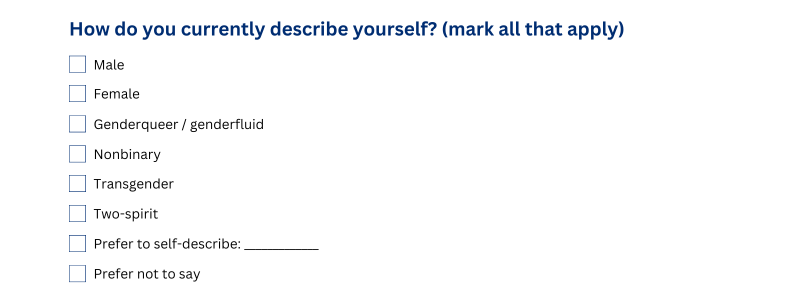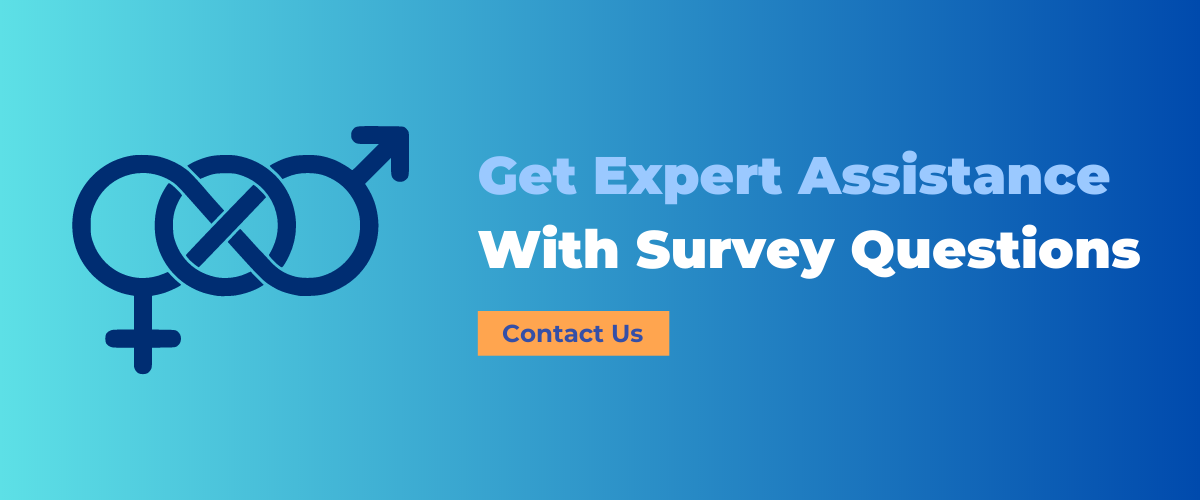This post is part of a series introducing IntelliBuilder, our drag-and-drop survey editor. Below,...
The first questions about a person's sex appeared in the 1790 US Census. In recent years, researchers have increasingly asked questions about gender and sex separately to increase accuracy and promote inclusivity. In fact, in 2020, around 55% of such survey questions included three or more gender answer options, as opposed to the 80% that only offered two options ten years ago (State of Surveys Report: 2023).
Researchers have not yet agreed on the "correct" way to ask gender questions in online surveys. Still, best practices are emerging to help ensure that sex and gender are not conflated and that survey measures accurately reflect the diversity of the population.
Why Gender Questions Matter
Gender is a social construct shaped by society's cultural expectations and norms. It is affected by factors such as religion, language, family dynamics, and more. Unlike sex, which is assigned at birth based on physical characteristics, collecting information about gender more fully encompasses the socio-cultural and psychological experiences important to research projects.
According to Pew Research Center, "Gender affects how a person sees and is seen by the world. It's predictive of things like voting behavior, the wage gap and household responsibilities."
A note about terminology: sexual orientation is often referenced alongside gender questions, abbreviated as SOGI (sexual orientation and gender identity). It is worth noting that sexual orientation is distinct from sex and gender. While you may see SOGI referenced in the context of gender questions below, the focus of this post remains limited to sex and gender questions.
Best Practices for Gender Questions
Gender questions are nuanced and require particular attention to context, verbiage, and placement. To properly conduct gender questions, researchers should follow guidelines such as using precise language, avoiding assumptions, and validating responses, as well as the additional best practices listed below.
Keep Sex and Gender Questions Separate
It is important to remember that sex and gender are separate concepts and require individual questions. Sexual characteristics are determined by the chromosomes and biological characteristics of a person. Thus, these questions are often simple and direct, for example:
What is your sex?
1. Male
2. Female
3. Intersex
Alternately, you may see this question phrased as "What sex were you assigned at birth?" In either case, you acknowledge the binary nature of asking a question about biological sex.
Don't Ask for More Than You Need
Unless it is necessary to reach the survey objectives, questions about gender may be omitted. This is frequently true for B2B research and studies that already include sex in their standard demographic data collection.
Other gender-related questions, such as gender presentation (how you outwardly express your gender) or preferred pronouns, are frequently unnecessary and should be avoided unless relevant to your research objectives.
Provide Write-In Options
Write-in options accommodate respondents who do not identify with the pre-defined gender choices. The wording of write-in options is critical to avoid confusion or a sense of judgment.
Examples of empowering write-in options include:
- "I use a different term"
- "Prefer to self-describe"
- "A gender not listed here"
Examine Your Question Placement
It is common to group sex and gender questions with other demographic questions, but you may wish to group them with questions specific to your study. For example, in a study about access to health care, the gender questions could be grouped with questions about insurance coverage, while your question about sex is placed alongside questions about race and ethnicity.
Use Inclusive Language
The Federal Committee on Statistical Methodology (FCSM) 's Updates on Terminology of Sexual Orientation and Gender Identity Survey Measures report acknowledges that when respondents do not see themselves represented in the categories offered, they have challenges responding. This lack of representation can result in lower levels of engagement and a reduced likelihood of survey completion.
When creating your list of potential answers, aim to strike a balance between inclusivity and survey usability.
Pew Research also notes that proponents of additional gender response options may perceive the lack of other options as exclusionary. This can be remedied by offering additional options in the choice set that are representative and inclusive of all voices.
There are several common gender categories, including, but not limited to:
- Male
- Female
- Genderqueer or genderfluid
- Nonbinary
- Transgender man
- Transgender woman
- Two-spirit
Consider Opt-Outs
If balancing the survey, sex or gender demographic information will be required upfront. If you are not balancing, however, these questions can be asked at the end of the survey and made optional, or you can provide a "prefer not to share this information" answer choice.
The FCSM also cautions that while item nonresponse is relatively low for SOGI questions, even low rates for nonresponse can be problematic when measuring a small population.
4 Examples of Inclusive Language in Gender Survey Questions
The use of inclusive language builds trust with survey participants. Although it is impossible to create a choice set for all gender options, it is feasible to use terminology that can be understood across most English-speaking countries to reflect LGBTQ+ identities.
Example #1: Very Inclusive Gender Question

The gender question above uses inclusive language, incorporating multiple gender identities while still keeping the response list manageable. Using a multi-select format allows participants to better align themselves with the answer options, including those with multiple gender identities. The write-in option provides space for identities outside the choice set, and a prefer not to say option allows participants to opt out of the question entirely.
Pew Research Center phrases their question precisely to ensure inclusivity: "Do you describe yourself as a man, a woman, or in some other way?" with a write-in option for the respondent to describe themselves. Pew views this verbiage as more inclusive than the binary responses of "male" and "female" and feels this phrasing more accurately captures data representative and inclusive of all types of voices.
Example #2: Reasonably Inclusive Gender Question

The way this question is framed, responses are limited to a smaller choice set; however, there is a fill-in option to self-describe and an alternative to opt out of the question entirely.
Example #3: Minimally Inclusive Gender Question

While this question does provide options beyond male and female, it offers a limited number of alternatives and fails to capture more nuanced gender demographics.
Example #4: Non-Inclusive Gender Question

Gender options should not be treated as binary or lumped together as "other" without a write-in option. This is dismissive and marginalizing to people who identify as non-binary or have other gender identities.
Additionally, some people identify with multiple gender identities, such as female AND transgender or Male AND genderfluid. Without additional options or opportunities for write-in answers, the data collected is unlikely to represent the true characteristics of the population being studied.
Testing and Iteration
When testing your overall standards, pay close attention to any sex or gender questions in your questionnaire.
If you can pilot test with a group of respondents, aim for diversity and ask about clarity, inclusiveness, and sensitivity. Use this feedback to make adjustments before fielding the survey.
Use Cases: Gender Questions in Research
In the world of healthcare, Stanford University’s Gendered-Related Variables in Health Research states that medical evidence has shown that both sex and gender interact to influence health and disease. Analyzing the influence of gender on health requires tools that disaggregate these dimensions and quantify them. “Conflating birth sex and gender identity, however, can lower the precision of survey research.”
The significance of gender in research is not limited to healthcare. Another Stanford case study, the Quality Urban Spaces: Gender Impact Assessment, showed the impact of gender data on city planners. By including gender questions in their surveys, city planners designing family-friendly streets and public spaces were able to understand who benefits from urban design and who is left out.
Other study use cases include:
- Employee engagement
- Employee satisfaction
- Organizational culture
- Labor market studies
- City planning
- Customer surveys
- Consumer market research
Additional Resources
Below are a few resources you can browse if you are interested in learning more about sex and gender questions in online surveys:
- National Academies Science, Engineering, Medicine - Measuring Sex, Gender Identity, and Sexual Orientation for the National Institutes of Health
- Williams Institute - Best Practices for Asking Questions to Identify Transgender and Other Gender Minority Respondents on Population-Based Surveys (GenIUSS)
- American Psychological Association - Inclusive Language Guidelines
- Vanderbilt University - How to Ask About Sexuality/Gender
- United Nations - Toolbox for Using Gender-Inclusive Language in English
Subscribe to our Monthly Newsletter
Related posts


Survey quotas are vital for gathering representative, accurate research results. Without them, your...

Healthcare is a fast-growing and changing industry. Legislative changes, regulatory changes,...

